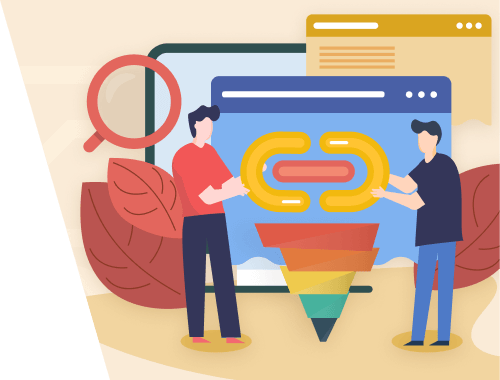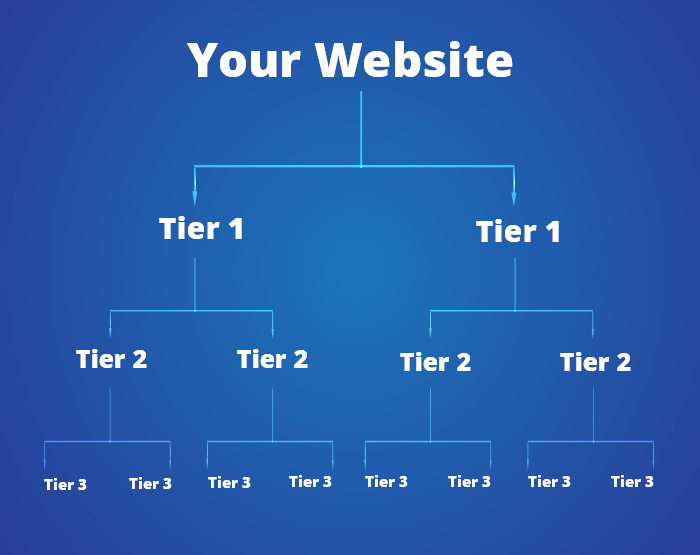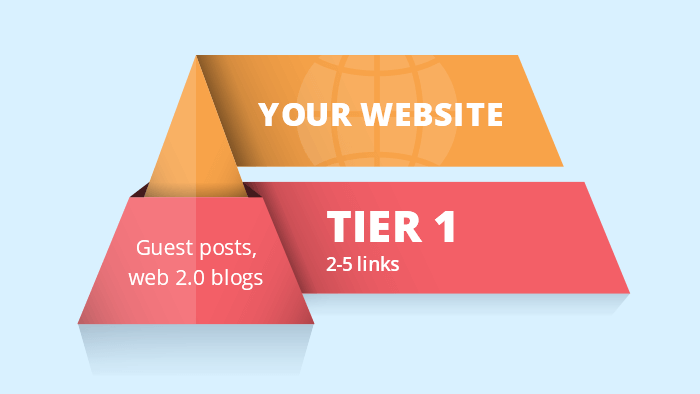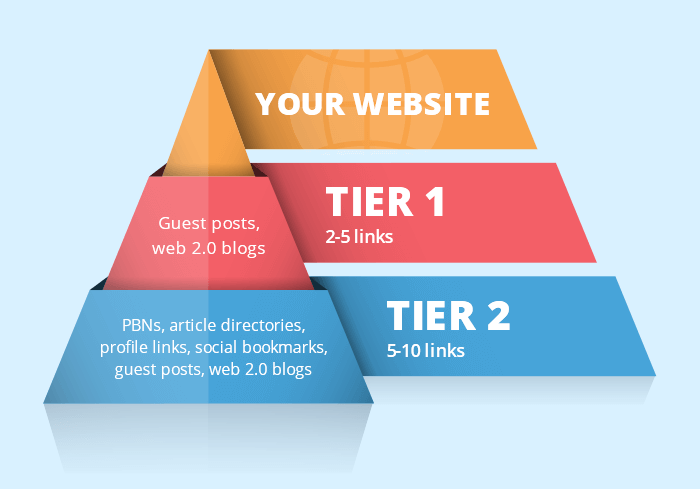40359
•
8-minute read


Backlinks do not come equal. Some are very powerful, while most are just meh. Curiously, there is an SEO strategy out there that says it doesn't have to be this way. In this article, we will look at tiered link building and whether or not you should use it to manipulate the power of your backlinks.
Before jumping to the link-building how-to, let's first learn the basics. Tiered link building is about creating backlinks for your backlinks. The main goal is to increase the amount of link juice passed from your backlink profile to your main website.
The way it works is you have a tier 1 backlink pointing to your main website, then a few tier 2 backlinks pointing to a tier 1 backlink, and then a few tier 3 backlinks pointing to each tier 2 backlink:

At first, tiered link building sounds like a silly idea. Why not have all of your backlinks point directly at your website? Why complicate things with second and third-tier backlinks? Well, here are some of the most common benefits of having a tiered backlink profile (provided they are of good quality – here's how to check backlink quality):
High-quality backlinks are expensive and time-consuming. Let’s say you want to publish a guest post on a respectable industry blog. The cost is likely to be between a few hundred dollars and a few thousand dollars. Not accounting for the time it would take to actually write and edit the post. So, there is probably a limit to how many quality backlinks you can afford.
One way to solve this problem is to build lower quality backlinks to your original backlinks. Lower quality backlinks are a dime a dozen and barely take any time to create. You can build a bunch of them at a fraction of the cost and magnify the effect of your original backlinks.
The best part is that you don’t need to have advanced expertise to get published on these cheaper guest posting websites. Besides, even if you're in a highly competitive niche, lower-quality sites have lower standards. This allows you to pass on some link equity while still maintaining a strong backlink profile.
It’s actually very convenient to have a couple of degrees of separation between your main website and your lower quality backlinks. Say, you feel like a particular batch of second or third tier backlinks is hurting your website. All you have to do is go one tier up and remove the backlink pointing towards your website. You make one clean cut and remove dozens or even hundreds of backlinks from your profile.
The influence of second and third-tier backlinks is not as strong as the influence of your primary backlinks. They are not pointed directly at your website, so, even if they violate any of the Google guidelines, your website will not be implicated. Not immediately.
It means you can be much bolder when experimenting with your tiered backlinks. You can try different tools for building different batches of backlinks, try different platforms for creating profiles and posting comments, and be as arrogant as you want. Use trial and error to see which methods work and which don’t, and easily remove any backlinks that begin to threaten your website.
In most online communities self-promotion is heavily frowned upon. Even if you do a paid guest post, you’d often have a limit to how many times you can link back to your own website. So, instead of linking to your own website, why not link to one of your tier 1 pages? You’ll send some link juice in your general direction and avoid the risk of being called out for self-promotion.
For those of you who are building backlinks artificially, the challenge is to pass them as natural. This means there should be a healthy mix of dofollow and nofollow links, high-quality and low-quality links, and links from a variety of websites, including blogs, forums, social networks, and many others. And as Google is getting better and better at identifying link schemes, these backlink profiles need to be more and more sophisticated.
In this regard, a tiered backlink profile is a way to gain link depth and diversity. It allows you to introduce some organized chaos to your linking scheme, possibly throwing Google off the scent.
Tiered link building is a gray-hat SEO practice at best, which means that it does come with certain risks:
It could take quite some time and a little bit of money to implement tiered link building on your website. And yet, the influence of second and third-tier backlinks on your rankings is very marginal. So the biggest risk here is that you are not investing your resources wisely. There is a long list of SEO tactics that you should go through before you can afford to waste your time on tiered link building.
Building a believable backlink profile is more art than science. If you get carried away, you will be at risk of breaking one or more Google guidelines, namely the ones against link schemes, automatically generated content, and scraped content. If that happens, the best-case scenario is Google will ignore a part of your backlinks. Worst-case scenario — your website will be slapped with a manual action or deindexed.
Most link schemes and other black-hat SEO tactics are considered to be short-term strategies. Eventually, either Google will catch up to your tricks or you will get tired of doing maintenance on your fake backlinks and the whole thing will come crashing down. Depending on what other strategies you have going on, you might end up starting from scratch. So, even if you decide to try tiered links, make sure it’s just a part of your overall strategy. Preferably a small one.
As a rule of thumb, the quality and the cost of your links drops dramatically as you move further away from your website.
First-tier links are your regular backlinks that point directly to your website. These links should be beyond reproach. First-tier links should be editorially placed within unique copy, as well as fit other criteria for backlink quality.
The best way to build first-tier links is by finding established websites within your industry and asking them for a guest post. Those of you who use SEO SpyGlass can find first-tier prospects with just a few clicks. Go to Domain Comparison > Link Intersection and add a few of your competitors. The tool will compare your backlink profiles and tell you which websites link to your competitors but don’t yet link to you:

The beauty of this method is that you find prospects who are interested in your niche, open to collaborations, and don’t have an exclusive relationship with any of your competitors. All of these factors mean they will be more likely to consider your guest post proposal.
For an extra step, use the filters to remove low authority websites from the list. Also, make sure to remove any websites that do not offer dofollow links. Now you’ve got yourself a list of top-notch backlink prospects.
The second best way to build first-tier links is by creating your own blogs on platforms that allow dofollow links. The benefit of this method is that there is no entry barrier. You don’t have to pay anyone to have your content placed and you don’t have to go through an editorial screening process. The drawback of this method is that it’s quite labor-intensive. You would have to build a number of minimally viable websites and then fill them with content.

Black-hat experts recommend creating a couple of first-tier links, generally no more than five. For the content, it is recommended to write a couple of original articles and then rewrite them manually for each of your fake blogs. To avoid suspicion, make sure the articles have links to a variety of industry websites — not just yours.
The requirements for second-tier links are a little more relaxed. Ideally, second-tier links would be placed within your other guest posts on high authority websites. But anything that’s not outright spam is fair game. High-quality PBNs, article directories, profile links, social bookmarks, and web 2.0 posts are all considered to be acceptable sources of second-tier backlinks. As long as there is intelligible context and you care to place the links manually.

It is recommended to create between a couple of second-tier backlinks per each first-tier backlink. Make sure to maintain the diversity of sources, contexts, and anchor texts.
Finally, third-tier links is where you can throw caution to the wind. At this level, it is perfectly okay to use tools like GSA or RankerX to autogenerate backlinks at scale. This time you can go as low as blog comments, but also poor quality directories, bookmark websites, and web 2.0s. The only rule here is that you should point your third-tier links at second-tier links only. Do not compromise your main website and do not compromise your first-tier link partners.

Now, the number of third-tier links should be massive. First, because very few of these automated links will get indexed by Google and many of them will disappear over time. Second, because the amount of authority passed from third-tier links to your website is minuscule. So, if you want to move the needle, you'd have to create thousands of third-tier backlinks.
Tiered link-building is an old-school gray-hat SEO tactic. Today, Google has gotten so good at identifying link-building schemes that it takes a lot of effort to fool the algorithm. Some black-hat experts now recommend building between five and ten tiers of backlinks using only the best of PBNs and only the strictest automation settings. In other words, building a passable fake backlink profile is now almost as much trouble as building a real backlink profile. And yet, there are some instances when tiered link building makes sense:
If you are entering a highly competitive market there might be no way to build legitimate backlinks at scale. In this case, tiered link building can help you gain some initial momentum. But keep in mind that it is a very short-term strategy that comes with a risk of penalty, so you should carefully consider all the pros and cons before proceeding.
Say you are doing an SEO guest posting and have an opportunity to link to another one of your guest posts — definitely go for it. Or say a partner has just published your guest post — help them promote the post using your own channels and you might get a couple of organic second-tier backlinks from your audience. Basically, be on the lookout for organic opportunities to create backlinks not just for yourself, but for your backlink partners as well.
Tier link building is a curious concept. It was invented as an answer to the Penguin update — an attempt to remove the risk but keep the juice of low-quality backlinks. Some in the SEO industry say that tiered links are a thing of the past, others claim that they work just fine. Do you have any experience with tiered links? Do you think it’s worth building them today? Let us know in the comments below.



